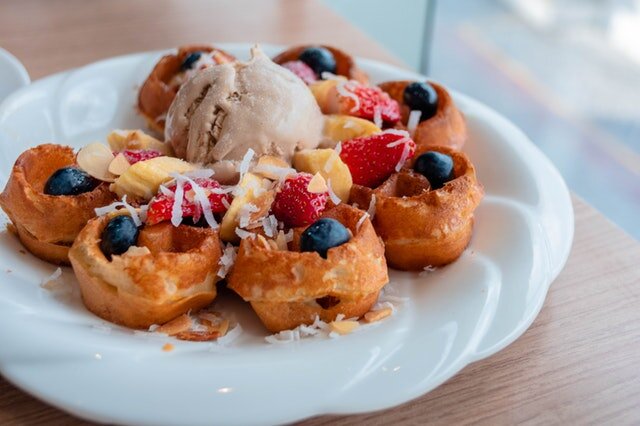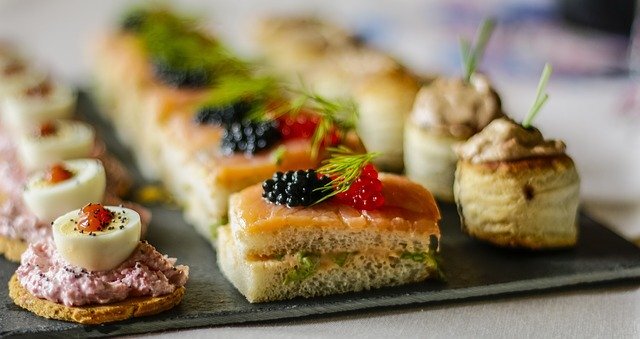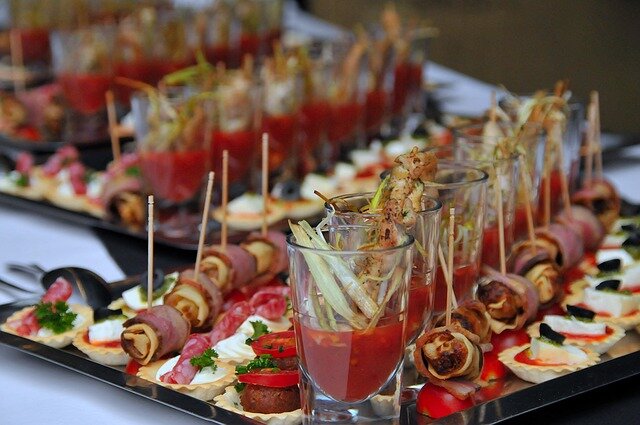What to eat in Madrid: 10 Spanish Specialties
/What to eat in Madrid: 10 Spanish Specialties
Experiencing the city by trying traditional local cuisine has become one of our favorite things to do in Madrid!
In this article, we are going to discuss one of the most important topics for travelers headed to Madrid. What to eat in Madrid and how much does it cost?
Madrid has become one of the most recognized culinary capitals of Europe. The capital has adopted all the best from traditional Spanish foods: from Basque tapas bars to avant-garde Catalan chefs. Every day tons of fish and seafood are delivered to Madrid, and although the city is located far from the ocean, it has the second-largest fish market in Spain.
When planning your Spain itinerary, make sure to devote at least 2 days to Madrid. This way you will not only be able to explore the city but have plenty of meals to experience the local cuisine. For the locals, food in Madrid is an important part of life, so the city has such a huge number of bars, cafes, restaurants and taverns to cater to each and every necessity.
In this Madrid food guide, you will learn:
What to eat in Madrid? Our Top ten traditional Spanish foods to try.
Best restaurants to try typical Spanish food in Madrid and how much does it cost.
A la madrileña – Madrid-style
Clearly, you can taste the dishes that have a la madrileña in the name only in Madrid. This prefix is added to completely different dishes, but there are several basic ones. So, here goes our guide on what traditional food to eat in Madrid, where and how much would it cost.
1. Cocido madrileño – Meat and Chickpea Stew
A true leader of Madrid gastronomy. Locals rightfully call cocido a star or a pearl of Madrid cuisine.
In reality, it is a thick soup with meat, sausages, vegetables or chickpeas. According to the method of preparation, it somewhat reminds of Moroccan couscous. Same as for the Arab couscous, cocido requires different types of meat to be cooked in a clay pot with vegetables and chickpeas for four hours. It is then served to the table in several portions:
first rich and delicious broth with rice or noodles.
then vegetables or just chickpeas with soft and tender bacon.
and, finally, meat and sausages (for example, a dish with at least two chorizos, two morcillas (blood sausage), half chicken, delicious pork knuckle, two pork legs and four or five pieces of beef).
Moreover, different types of meat are used to prepare cocido: beef, pork, chicken, and various types of sausages.
Where to try?
One of the best restaurants in Madrid, Malacatín, has specialized in the preparation of cocido for over a hundred years. The motto of this restaurant is – "If you eat the whole dish completely, we pay for it." I don’t know if it is true though, as we didn’t manage to finish the dish. There is a flat rate of 21€ per for a generous portion. Normally, the prices range anywhere between 20€ and 35€.
Best restaurants in Madrid to eat Cocido madrileño:
- La Bola - cocido cooked in clay pots over oak charcoal.
- Casa Carola – a cheaper option in the heart of Madrid.
- La Gran Tasca – is located outside of the city center and serves huge portions of cocido.
- Los Galayos – a cheaper option in the heart of Madrid.
2. Caracoles a la madrileña – Snails Madrid-Style
Snails stewed for 3-4 hours over low heat in broth with the addition of ham, garlic, paprika, and chili pepper. Once, this dish was the food of the poor because of its low cost, but soon it became popular in high society as well. Now this dish is popular in Madrid bars and many restaurants. It can be served in a clay pan (not always), and usually like tapas or pinchos (sometimes for free) to accompany your glass of red wine. This dish is prepared in a meaty broth with different types of sausage, onions, wine, and spices. We personally consider Caracoles a la madrileña to be one of the best types of tapas in Madrid.
Best restaurants in Madrid to eat Snails Madrid-Style:
Really, you can try snails in most Madrid taverns, for example:
- Casa Amadeo - serving snails since 1942.
- Los Caracoles – the place is literally named “The Snails”.
- Taberna Antonio Sánchez – traditional restaurat located in the center.
Madrid food not your thing? Check out this Traditional German Food guide
3. Tortilla Española – Spanish Omelette
Wondering what to eat in Madrid for lunch or dinner (not for breakfast as you might have thought)? Try this super simple dish – mixed fried potatoes and eggs which then are poured and fried on the pan. As a result, you get a thick “cake”. Locals have been eating this dish since the XVII century at any time of the day. This dish has become one of the varieties of tapas.
Despite the seeming simplicity of the ingredients, in advanced restaurants in Madrid, chefs are not afraid to stray away from the traditional recipe of this typical Spanish food: they serve finely grated potatoes in a cup under protein foam or bake potato pieces together with poached eggs.
Best restaurants in Madrid to eat Spanish Omelette:
- Casa Dani – authentic Spanish dishes at great prices.
- Juana la Loca – tortilla with caramelized onion.
- Sylkar – they haven’t changed their tortilla recipe since 1970.
4. Huevos Estrellados or Huevos Rotos – Broken Eggs
Another popular local dish and typical Spanish breakfast food that you should definitely try. “Huevos Estrellados”, can be translated as "star eggs" but a more correct version is "broken eggs" aka “Huevos Rotos”. Eggs are served on a patty made from fried potato with the addition of Jamon or chorizo (a type of Spanish sausage). The dish is often found in restaurants where you are offered tapas.
Best restaurants in Madrid to eat Broken Eggs:
- Taberna Los Huevos de Lucio – this one is literally translated as “eggs tavern”.
- Taberna Casa Lucio – one of the oldest restaurants in Madrid and famous for its huevos rotos.
5. Cochinillo Asado – Suckling Pig
If you are wondering what Madrid is known for and looking to check of one of the major bucket list items found in Madrid, then this is the one!
The whole roast suckling pig is a national dish that originated in the ancient Spanish kingdom of Castile. This dish was inspired by the tradition of farm-to-table eating. While roast suckling pig is one of the most typical dishes in Castillan cuisine, Madrid also has a long tradition of making and eating Cochinillo Asado. The pigs are typically raised on family farms within 100 miles from Madrid, keeping everything local to and as close to the tradition as possible.
There are a number of restaurants specializing in this dish in Madrid including the famous Botín, as well as, Los Galayos and Asador Real.
Best restaurants in Madrid to eat Suckling Pig:
*Botín – one of the world's oldest restaurants serving customers since 1725.
*Los Galayos – in a touristy location but still full of locals.
*Asador Aranduero – it's so popular that it has two locations.
6. Bocadillo de calamares – Calamari sandwich
This is some of our favorite local food. The main ingredient is squid coated in flour, deep-fried in olive oil and served in a fresh bread roll. This Madrid food is sometimes called Roman squid (although this dish is unknown in Rome). According to one version, the appetizer was invented by the Jesuits who allegedly preferred to eat squid during fasting.
A good bocadillo de calamares costs anywhere between 2.70€ and 6€.
Best restaurants in Madrid to eat a squid sandwich:
Bocadillos de calamares are served mainly in small traditional bars and cafes located around Plaza Mayor. For example, Bar La Campana, La Ideal, Bar Postas, Casa Rúa.
7. Callos a la madrileña – Callos
Callos is a common Spanish stew traditional to Madrid, this dish can be found almost everywhere. This Spanish food is a fatty and hearty dish that has been around for centuries. “Callos” is a piece of beef stomach, pre-soaked in vinegar and stewed with morsel and chorizo, with the addition of spices: bay leaf, paprika (which gives the dish a distinctive color), hot pepper, nutmeg, onion, garlic, and tomato paste. The traditional Spanish dish is cooked for at least three hours. If you are wondering what to eat in Madrid in winter, Callos is a great option as it is prepared mainly during this season and can be served both hot and cold.
Best restaurants in Madrid to eat Callos:
As a rule, Callos is presented on the menu as an independent dish, although in some places it can also be found as tapas. For example, it always appears on the list of free tapas in the El Lacón tavern.
- La Tasquita de Enfrente – restaurant of local Spanish cuisine.
- La Tasquería – a contemporary tavern.
8. Besugo a la madrilenã – Madrid style baked red bream
Madrid style baked red bream in a bread crumb - once a traditional Christmas dish, that is sprinkled with lemon, seasoned with breadcrumbs, parsley, garlic, olive oil and baked in the oven.
In the past, only aristocrats could afford this dish: as the fish was very expensive, it was brought to the capital from the coast in aquariums. The dish became more popular in the eighteenth century, during the reign of King Charles III. Now, this Madrid food is available to everyone.
Best restaurants in Madrid to eat Madrid style baked red bream:
Well except for the restaurants, Madrid-style red bream can be bought at the gourmet departments of large supermarkets. The whole fish of 1.5 kg will cost 30 euros. As for the restaurants:
- Restaurante Castilla – more European influenced cuisine, outside of Madrid center.
- Casa Hortensia – tradional, home-cooked Spanish food.
9. Soldaditos de Pavia – Pavia soldiers
This Madrid food is a rather symbolic dish - roasted pieces of marinated desalted cod served with a strip of roasted red pepper around them. This dish has been known since the sixteenth century. It is reminiscent of one of the biggest battles of the Italian war between the Spanish and the French - the Battle of Pavia in 1525.
It is possible to interpret the strip of red pepper in different ways: both as a belt where the soldiers attached a saber, and as a wide ribbon of Spanish noble officers.
Best restaurants in Madrid to try Pavia soldiers:
Casa Labra – is one of the most famous places to try pavia soldiers.
10. Churros
It is the most popular dessert in Madrid that you will find on every street, in cafes, bars and in the small kiosks. Usually, in the same establishment, you can find porras - almost like a double churros.
In Madrid, locals prefer to eat Churros for breakfast. Churros are made from custard dough and are deep-fried. According to one version, a trend for churros with hot chocolate appeared back in the 18th century. Now Churros are among locals as the most favorite food.
Best restaurants in Madrid to eat Churros:
- San Gines confectionery – is the most popular place to try churros.
- Chocolatería Valor – Valor is a chocolate brand most loved in Spain and they have a few establishments around the city.
What are Spanish tapas and pinchos?
Everyone who has been to Spain, and have even reached the Basque Country, probably wondered about this topic. What is the difference between pinchos and tapas? And how did it happen that a whole cult arose around ordinary sandwiches? Briefly and essentially we explain the difference.
So, let's start with a simple one. On the left photo are tapas. On the right photo are pinchos.
Both of them are traditional Spanish snack. Tapas is a name distributed more or less throughout the country. Except for one region. In the Basque Country, small appetizing snacks for wine or beer are called pinchos.
There really is a difference between tapas and pinchos. Firstly, historical difference. Tapas were originally a free appetizer for a glass of wine, so no one really bothered over their preparation. But pinchos have always been a treat that you had to buy separately.
Tapas is a simpler appetizer, pinchos is more exquisit. In fact, anything can be named tapas: even a plate with chopped chorizo sausage, olives or nuts.
Pinchos most often are small sandwiches with an interesting combination of products on a baguette, slightly fried in olive oil. Both, tapas and pinchos can be served hot or cold.
Pinchos usually include seafood - cod, anchovies, octopus, shrimp or at least salmon.
Another difference is that pinchos are usually pierced with a skewer. Even the name “pincho” comes from the word “skewer”.
How did it happen that ordinary sandwiches occupied such a significant place in the culture of the Spanish? The answer is: traditionally, dinner in Spain is served late: from 9 to 11 in the evening. But what to do in the blessed time after work and before dinner? The Spanish found a way out: to go to tapas bars (or pinchos bars in the case of the Basques), sip wine or beer and have a snack.
You can experience tapas in Madrid and we recommend to try pinchos in their homeland – in San Sebastián.
There is another place where you can try something as similar as possible to pinchos. This is Venice, Italy where they are very proud of the local gastronomic specialty - “chiquetti”. In fact, this is the same: small sandwiches (usually with seafood) that you pick up on a plate as snacks for your well-deserved aperitif.
Best time to eat in Madrid and in Spain
Desayuno (Breakfast): from 7 a.m. to 9 a.m.
Most locals in Madrid start the morning quite late but you can find places to open early as it is a big city. The Spanish start coffee with churros, croissants, baguettes or any kind of pastry. So that’s the most typical kind of breakfast you will find.
Almuerzo (Mid-morning snack): from 10:30 a.m. to 11 a.m.
This one is meant for locals to skip the actual breakfast and for almuerzo they will pretty much have the same thing as for breakfast. So think about it as a second breakfast.
La Comida (Lunch): from 2 p.m. to 3:30 p.m.
This meal cannot be missed and it is kind of a big deal. Your lunch options will be countless, especially in Madrid. However, if you want to eat before 1-1.30, many places will be closed.
Merienda (Mid-afternoon snack): from 5:30 p.m. to 7:30 p.m.
This is a mid-afternoon snack for the after-work time. It can be churros with hot chocolate or some fresh fruit or ice cream in summer.
La hora del aperitivo (Tapas Hour): from 8:30 p.m. to 10 p.m.
At this time you will have some tapas and drinks, sometimes the tapas will come free with the drinks. It is typical to move from bar to bar, so you can check out different places. In many of them you will probably not get to sit, just enjoy the free space and socialize.
La Cena (Dinner): from 9 p.m. to 11 p.m.
You won’t find authentic Spanish dinner food before around 8:30 p.m. but trust us, it’s worth waiting for. Traditionally, dinners are a shared meal, if you’re going to eat with a group of friends, you can get shared platters of food called raciónes. You will be expected to order one ración per person.
Food markets in Madrid
Madrid's food markets have long ago shifted from being just markets to true centers of gastronomic culture, where you can not only buy fresh and high-quality products, try Spanish traditional cuisine, relax in a cozy cafe or restaurant, but also attend: food festivals, culinary seminars, and admire the unique architecture of the city.
Mercado San Miguel - one of Madrid's most famous markets and a must-visit one.
Food-wise you will find typical Spanish food here: tapas, seafood, paella and many shops with desserts.
Also, you will meet the crowds of tourists. It’s a paradox, but this is not bad at all: just be prepared that the noise, lines and prices here will be at the highest level, and there will be practically no free space for pure enjoyment.
If your goal is to check out every restaurant and shop, and have a bit more free space, then come here on a weekday in the morning.
Mercado San Antón – a market where you can cook a product you just bought.
This market is a place with a rich history as originally it was a street market but then it became too popular and got reconstructed into a modern masterpiece.
However, San Anton Market in Madrid has retained its original concept: the ground floor of the building is a classic market. On the second floor of the building, there is a food court where you can order dishes of traditional Spanish cuisine with a glass of fine wine or a traditional wine drink - sangria.
The third floor of the market hasan open-air restaurant offering some of the most delicious dishes in the area. The concept of the restaurant is very interesting, in addition to dishes from the menu, visitors can choose any product they like on the counter, and the chefs will prepare it to your taste with the addition of a side dish and sauces of the highest quality. This service is called “Cooking de la cocina de San Antón”.
Like it? Pin it!































































